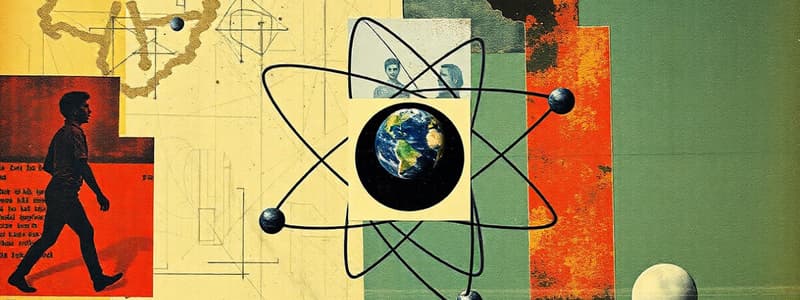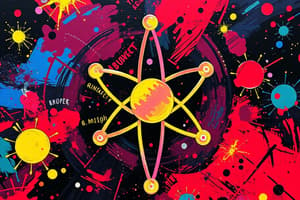Podcast
Questions and Answers
Rutherford's model of the atom proposed that electrons revolve around the nucleus in a defined circular path, similar to planets orbiting the sun.
Rutherford's model of the atom proposed that electrons revolve around the nucleus in a defined circular path, similar to planets orbiting the sun.
True (A)
What is the primary drawback of Rutherford's model of the atom?
What is the primary drawback of Rutherford's model of the atom?
- It could not accurately predict the wavelengths of emitted light from atoms.
- It failed to explain the stability of atoms (correct)
- It incorrectly proposed that electrons carry a positive charge
- It did not account for the existence of neutrons
What is the name of the positively charged center of an atom?
What is the name of the positively charged center of an atom?
Nucleus
The ______ rule states that the outermost shell of an atom can contain at most 8 electrons.
The ______ rule states that the outermost shell of an atom can contain at most 8 electrons.
Match the following subatomic particles with their corresponding properties:
Match the following subatomic particles with their corresponding properties:
Atoms with a completely filled outermost shell are highly reactive.
Atoms with a completely filled outermost shell are highly reactive.
Which of the following statements is TRUE regarding isotopes?
Which of the following statements is TRUE regarding isotopes?
What is the valency of an atom with 5 electrons in its outermost shell?
What is the valency of an atom with 5 electrons in its outermost shell?
What are the two fundamental particles that constitute the nucleus of an atom?
What are the two fundamental particles that constitute the nucleus of an atom?
The average atomic mass of an element is always a whole number.
The average atomic mass of an element is always a whole number.
What is the mass number of an atom with 15 protons and 16 neutrons?
What is the mass number of an atom with 15 protons and 16 neutrons?
The combining capacity of an atom is known as its ______.
The combining capacity of an atom is known as its ______.
Match the following isotopes with their respective applications:
Match the following isotopes with their respective applications:
Atoms of different elements with the same mass number are called ______.
Atoms of different elements with the same mass number are called ______.
Match the following terms with their corresponding definitions:
Match the following terms with their corresponding definitions:
Which of the following statements about isotopes is TRUE?
Which of the following statements about isotopes is TRUE?
Explain why the outermost shell cannot contain electrons unless the inner shells are completely filled.
Explain why the outermost shell cannot contain electrons unless the inner shells are completely filled.
The valency of magnesium is 1, as it can easily lose 1 electron.
The valency of magnesium is 1, as it can easily lose 1 electron.
Which sub-atomic particle is negatively charged?
Which sub-atomic particle is negatively charged?
Protons and electrons are found in the nucleus of an atom.
Protons and electrons are found in the nucleus of an atom.
Who discovered the neutron?
Who discovered the neutron?
E. Goldstein discovered _____ which are positively charged radiations.
E. Goldstein discovered _____ which are positively charged radiations.
Match the scientists to their discoveries:
Match the scientists to their discoveries:
What is the main failure of Dalton's Atomic Theory?
What is the main failure of Dalton's Atomic Theory?
Thomson's model of the atom is similar to that of a Christmas pudding.
Thomson's model of the atom is similar to that of a Christmas pudding.
What balanced proportion exists in an atom?
What balanced proportion exists in an atom?
What did Rutherford use to observe the structure of the atom?
What did Rutherford use to observe the structure of the atom?
Rutherford expected alpha particles to pass straight through the gold foil without any deflection.
Rutherford expected alpha particles to pass straight through the gold foil without any deflection.
What proportion of alpha particles were observed to rebound after hitting the gold foil?
What proportion of alpha particles were observed to rebound after hitting the gold foil?
The black seeds in a watermelon are compared to ________ in the atom.
The black seeds in a watermelon are compared to ________ in the atom.
Match the following observations from Rutherford's experiment with their implications:
Match the following observations from Rutherford's experiment with their implications:
What was the mass of the alpha particles used in Rutherford's experiment?
What was the mass of the alpha particles used in Rutherford's experiment?
Rutherford concluded that the positive charge of the atom is spread evenly throughout its volume.
Rutherford concluded that the positive charge of the atom is spread evenly throughout its volume.
What is the approximate radius of the nucleus compared to the radius of the atom?
What is the approximate radius of the nucleus compared to the radius of the atom?
Flashcards
Nuclear model of the atom
Nuclear model of the atom
A model proposing that atoms have a positively charged nucleus at the center and electrons revolve around it.
Nucleus
Nucleus
The central positively charged part of an atom containing protons and neutrons.
Rutherford's limitations
Rutherford's limitations
Rutherford's model failed to explain why electrons wouldn't spiral into the nucleus due to energy loss.
Bohr's postulates
Bohr's postulates
Signup and view all the flashcards
Energy levels
Energy levels
Signup and view all the flashcards
Neutron
Neutron
Signup and view all the flashcards
Octet Rule
Octet Rule
Signup and view all the flashcards
Electron distribution formula
Electron distribution formula
Signup and view all the flashcards
Rutherford's Model of an Atom
Rutherford's Model of an Atom
Signup and view all the flashcards
Alpha particles
Alpha particles
Signup and view all the flashcards
Gold foil experiment
Gold foil experiment
Signup and view all the flashcards
Particle deflection
Particle deflection
Signup and view all the flashcards
Conclusion of empty space
Conclusion of empty space
Signup and view all the flashcards
Positive charge concentration
Positive charge concentration
Signup and view all the flashcards
Nucleus radius
Nucleus radius
Signup and view all the flashcards
Unexpected scattering results
Unexpected scattering results
Signup and view all the flashcards
Structure of an Atom
Structure of an Atom
Signup and view all the flashcards
Protons
Protons
Signup and view all the flashcards
Electrons
Electrons
Signup and view all the flashcards
Thomson's Model of an Atom
Thomson's Model of an Atom
Signup and view all the flashcards
Canal Rays
Canal Rays
Signup and view all the flashcards
Limitations of Dalton's Atomic Theory
Limitations of Dalton's Atomic Theory
Signup and view all the flashcards
Isotopes
Isotopes
Signup and view all the flashcards
Mass Number
Mass Number
Signup and view all the flashcards
Average Atomic Mass
Average Atomic Mass
Signup and view all the flashcards
Isobars
Isobars
Signup and view all the flashcards
Atomic Number
Atomic Number
Signup and view all the flashcards
Valence Electrons
Valence Electrons
Signup and view all the flashcards
Valency
Valency
Signup and view all the flashcards
Stable Atoms
Stable Atoms
Signup and view all the flashcards
What is the valency of Hydrogen?
What is the valency of Hydrogen?
Signup and view all the flashcards
Calculating Valency
Calculating Valency
Signup and view all the flashcards
Uses of Isotopes
Uses of Isotopes
Signup and view all the flashcards
Study Notes
Structure of Atoms
- Atoms are composed of protons, neutrons, and electrons
- Atoms are the basic building blocks of matter
- Different types of matter exist due to different atoms
- Atoms contain charged particles
- Atoms can be divided into protons, electrons, and neutrons
Charged Particles
- Electrons are outside the nucleus
- Protons are located inside the nucleus
- Neutrons are located inside the nucleus
- Electrons have a negative charge
- Protons have a positive charge
- Neutrons have no charge
Properties of Particles
| Particle | Mass (kg) | Location | Charge (C) | Unit Charge |
|---|---|---|---|---|
| Electron | 9.11 × 10-31 kg | Outside nucleus | -1.602 × 10-19 | -1 |
| Proton | 1.673 × 10-27 kg | Nucleus | 1.602 × 10-19 | 1 |
| Neutron | 1.675 × 10-27 kg | Nucleus | 0 | 0 |
Discovery and Models
- J.J. Thomson discovered electrons
- E. Goldstein discovered protons
- Ernest Rutherford discovered the nucleus
- James Chadwick discovered neutrons
- Dalton's atomic theory stated atoms were indivisible. However, the discovery of subatomic particles disproved this aspect.
- Thomson's model of the atom resembled a watermelon or Christmas pudding with positive charge spread across like the red pulp, with electrons embedded like seeds.
- Rutherford's alpha-particle scattering experiment revealed a small, dense, positively charged nucleus at the center of the atom, with electrons orbiting it.
- Rutherford's model failed to explain the stability of atoms.
Bohr's Model
- Bohr proposed that electrons orbit the nucleus in discrete energy levels, preventing their collapse into the nucleus
- Electrons do not emit energy while moving in these stable orbits
- Each orbit has a definite energy level
- These orbits are also called energy levels or energy shells
Neutrons
- Neutrons were discovered in 1932
- They have no charge and nearly the same mass as a proton
- They are found in the nucleus alongside protons
Electron Distribution
- The distribution of electrons in atoms is governed by rules, typically filling inner shells first
- The outermost shell can hold a maximum of 8 electrons, according to the octet rule
Atomic Structure of First Eighteen Elements Chart
- Valence electrons determine the chemical properties, reactivity, and combining capacity of elements
- Atoms with completely filled outer shells are less reactive
Isotopes
- Atoms of the same element can exist in different forms with the same number of protons (atomic number) but a different number of neutrons
- Isotopes have similar chemical properties but different physical properties
Isobars
- Atoms of different elements have the same mass number but different atomic numbers
- Isobars have different chemical and physical properties
Studying That Suits You
Use AI to generate personalized quizzes and flashcards to suit your learning preferences.




